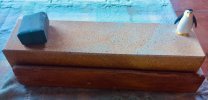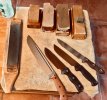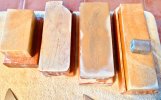I have a several JNATS that I use exclusively on my knives.
They can be costly and just as anything else these days: they can and will be faked from sellers trying to scam the uninformed buyer.
These took me several years to aqcuire after a couple of long negotiations on 2 thru a friend in Japan.
2 came directly from old classic barbershops located in Japan.
The key I found is to "not be in a hurry" to buy, and a seller willing to provide a money back guarantee on your satisfaction.
I have never once regretted acquiring (paying for) mine and I have learned huge volumes of information about geology in general, Japanese regions & its geology, Japanese sword making, & the sharpening process & metal types, plus much information on the ancient "sword masters" & the historical knife makers of Japan along the way.
I have found using mine they provide a form if meditaion and or a "therapy like" process.
They give me great satisfaction to use.
View attachment 1068914 View attachment 1068915 View attachment 1068920








